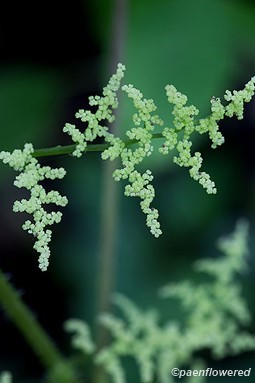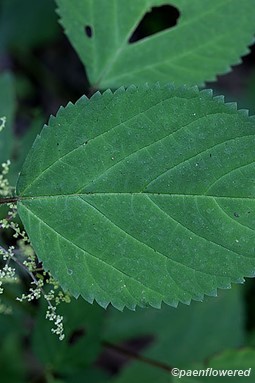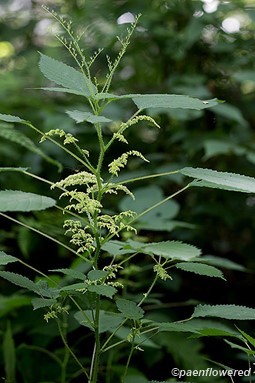Urtica dioica
A European nettle with stinging hairs on both sides of the leaves
Urtica dioica stinging nettle
Add to MyPlants View Locations
The stinging nettle is a member of the nettle family. It is native to Europe, Asia, Northern Africa, and Western North America and introduced to northeastern North America. Because the flowers are wind-pollinated, they are not very attractive, but worthy of attention because of the danger involved in getting too close to this plant. There are six subspecies of this plant. Five of them are covered with coarse, stinging hairs, including the two native to America. A European subspecies has also been introduced to North America.
The stinging hairs are hollow, located on the stems and on the underside of the leaves. When touched, these stinging hairs shed their tips. These act as miniature hypodermic needles to inject histamines and other chemicals that cause a stinging sensation in the skin of humans and animals. Dogs allowed to run through stands of nettle have been known to be seriously affected. There are also many non-stinging hairs on both the stem and leaves.
The small individual greenish flowers are in slender clusters in the leaf axils. There are usually four slender spikes of flowers per stem node. Male and female flowers are often on the same plant but grow at different levels. Male flower spikes are longer than female spikes. The introduced European subspecies has separate male and female plants. The blooming period is June to September. The seeds are small enough to also be distributed by air.
The stem of the plant is hollow and four-angled. The plants grow 2-4 feet tall in open woods, along roadsides and in waste places, wherever there is sufficient moisture and phosphorus in the soil. It grows throughout North America but seems more common in the North and the West. It is found in almost all counties of Pennsylvania. The leaves are heart-shaped, coarsely toothed, and have long petioles. It is also called the common nettle or tall nettle. The plant can spread by underground rhizomes and often forms dense growths.
The best medical treatments for stings caused by nettles are lotions that contain antihistamines or cortisone. There are a number of folk remedies, but these have very limited scientific validation. The stinging sensation will, however, usually wear off in a few minutes or hours at most, even without treatment. Extreme exposure, however, may require medical treatment.
The stinging nettle is edible and it is said that the leaves taste much like spinach. Soaking the plant in water or cooking them removes the stinging hairs and makes them safe to eat. There are a number of ethnic recipes in Europe and Asia that utilize the plant and teas made from the leaves have been used in folk medicine. The stem fibers have been used to make a coarse type of cloth and dyes have been extracted from the roots and leaves.
Habitat & Range
Naturalized in floodplains and other low, moist areas.
Present throughout the state, with a higher concentration in the south.
| EMP: | FACU |
|---|---|
| NCNE: | FAC |
Phenology
Flowers June to September.
Plant Codes
S-rank: S5 (Secure)
G-rank: G5 (Secure)
Urtica dioica stinging nettle
Synonyms: Urtica dioica ssp. dioica, Urtica proceraAdd to MyPlants View Locations





Comments
Have you spotted this plant in your area? We'd love to hear about your experience! Share your comments or questions about the plant below. Comments are moderated before posting.